Services on Demand
Article
Indicators
Related links
-
 Cited by Google
Cited by Google -
 Similars in Google
Similars in Google
Share
Water SA
On-line version ISSN 1816-7950
Print version ISSN 0378-4738
Water SA vol.38 n.2 Pretoria Jan. 2012
ARTICLES
Effects of tailwater depth on spillway aeration
Egemen ArasI, *; Mehmet BerkunII
IKaradeniz Technical University Faculty of Technology, Department of Civil Engineering, 61830, Of/Trabzon, Turkey
IIKaradeniz Technical University, Faculty of Engineering, Department of Civil Engineering 61080, Trabzon, Turkey
ABSTRACT
Hydraulic structures such as spillways or weirs with their water-air controlling mechanisms are not only important for their structural properties but also for their effects on downstream ecology. Tailwater depth is an important factor affecting dissolved oxygen transfer and aeration rates of spillways. In this study, effects of tailwater depths and discharge values on the aeration efficiencies of laboratory-model smooth and stepped spillways were investigated. Changes of tailwater depths affect the dissolved oxygen transfer rates and aeration efficiencies are affected more than 100%, resulting in supersaturated dissolved oxygen concentrations. Tailwater depth is a significant parameter in the design of the spillway and the stilling basin of dams. Therefore, this value should be estimated correctly.
Keywords: Aeration, tailwater depth, dissolved oxygen, spillway, supersaturated
Introduction
Dissolved oxygen (DO) affects water quality directly. Spillways with their water-air controlling mechanisms are not only important for their structural properties but also for their effects on stream ecology (Aras and Berkun, 2006). The concentration of DO in water has long been a significant concern in water quality management and certain minimum levels are necessary for the maintenance of aquatic biological systems and for either separate treatment or concurrent assimilation of treated municipal and industrial wastewaters (Ling et al., 2010; Baylar et al., 2009; Baylar et al., 2010; Aras and Berkun, 2010).
Downstream DO concentrations are affected by various factors such as flow rates, water temperature, and hydraulic characteristics of weirs and channels. Tailwater depth is an important factor for spillway aeration. Aeration efficiency increases with the increasing tailwater depth (Chanson, 1994). The effect of tailwater depth is limited since an infinite depth for bubble penetration does not exist. An average maximum tailwater depth can be determined for the combinations of flow and dropping heights, to assess a potential depth value of the limiting aeration efficiency. Pöpel (1974) noted that aeration efficiency remains constant where downstream water depth is greater than 2/3 times than the falling height. Avery and Novak (1978) stated that tailwater depth should be 0.6 times greater than falling height to have an effect on DO transfer efficiency. Previous experimental and field research studies, by Balachandar et al. (2000); Mossa et al. (2003); Tsai et al. (2004); Sui et al. (2008); Sankar et al. (2008) and Aras and Berkun (2008), have provided equations and graphs to show the effects of tailwater depths on aeration.
Avery and Novak (1978) gave hydraulic jump models for weirs and cascading spillways and noted that oxygen deficiency is a function of the Reynolds number; effect of tailwater depth is important and effect of channel width is negligible for the optimum aeration efficiency. The following equation resulted from Avery and Novak's (1978) modelling studies:

where:
E20: aeration efficiency at 20°C,
F: Froude numberd
R: Reynolds number
Nakasone (1987) worked with 3 different laboratory-model aeration systems to describe the aeration efficiency for different flow regimes (Table 1) and found that tailwater depth should be included in the formulas to calculate aeration efficiency along with the falling height and discharge. Aeration efficiency increased until a certain flow rate and then decreased. Optimal flow rate was given as 235 m3-h-1 and optimum tailwater depth was 30% of the falling height. The following equations were developed:

Nakasone (1987) developed the following equation taking the tailwater depth into account:

This equation can be converted into the following form for hydraulic structures having DH>12 m and qw >0.065 m2.s-1 (Nakasone, 1987):

where:
HC: critical water depth
q: unit discharge
D: drop height
H: falling height
r: deficit ratio
kN1 : coefficient
ΔH: height difference
qW: unit width discharge
dt: tailwater depth
These equations were verified in some models and prototype work for 0.011 to 7.8 m2.s-1 discharges, 0.24 to 5.8 m falling heights and 0.25 to 7.5 m tailwater depths. Nakasone's (1987) results showed that the aeration efficiency increases with increasing tailwater depth. It was indicated that aeration efficiency is independent of the pool depth in cases where the tailwater depth is greater than maximum penetration depth of air bubbles (Brattberg and Chanson, 1998; Rein, 1998). Watson et al. (1998) examined the oxygen transfer rates in the laboratory for a smooth spillway with a small elevation. Aeration efficiency increased with tailwater depth. Kim and Walters (2001) worked with small-scale prototypes in the laboratory and indicated that the oxygen-deficit ratio is a function of the tailwater depth, weir height, Froude number and fall height.
Materials and methods
This study was carried out using a laboratory model weir. Experimental set-up comprised an open channel consisting of a non-recirculated mechanism. Channel dimensions were: 400 cm length x 15 cm height x 7.5 cm width. A pump causes water to flow from the main tank to the edge of the channel. Water passes through a damper and reaches the spillway. Overflowing water from the spillway flows along the channel and travels into the discharge measuring bucket system (Fig. 1). Dissolved oxygen concentrations were measured at the upstream and downstream ends for various flow rates using an oxygen meter (HACH HQ10) at 10°C water temperature. Calculated deficit ratio and aeration efficiency values were converted to 20°C.
Two different weirs were tested, one being a smooth weir with 15 cm height, 10 cm length and 7.5 cm width and the second a 4-step weir with 13.5 cm height, 12 cm length and 7.5 cm width. Smooth and stepped spillways were composed of steel and timber. The nature of the crest profile is an ogee profile.
A 50 m3 main water tank provided water to the system with a 6.5 mg.ℓ-1 DO concentration so that a greater than 2.5 mg.ℓ-1 difference between upstream and downstream DO saturation concentrations could be obtained, in order to accurately calculate the aeration efficiency (Aras, 2009).
Tailwater depth and aeration efficiency values were investigated for 5 different discharge values. Tailwater depths were measured and compared and aeration efficiency was found for each discharge value. Tailwater depth was controlled using a ruler.
Results and discussion
Measured tailwater depths on the toe are listed in Table 2 and 3 and dissolved oxygen saturations downstream of the spillways are provided in Figs. 2 to 3. In Figs. 4 to 7, the relationships between aeration efficiencies and tailwater depths are analysed and in Figs. 8 to 9, the effect of discharge on the tailwater depths are investigated. Tailwater depth differences between smooth and stepped spillways for the same discharge values are compared in Figs. 10 to 11.
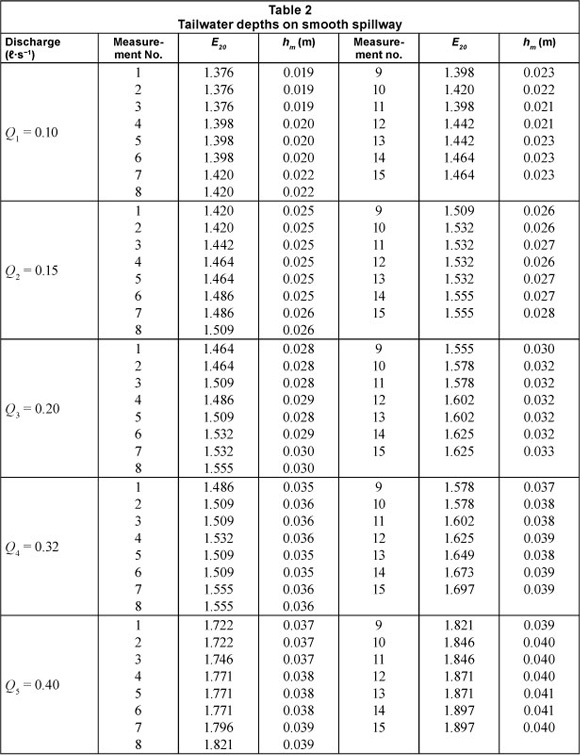
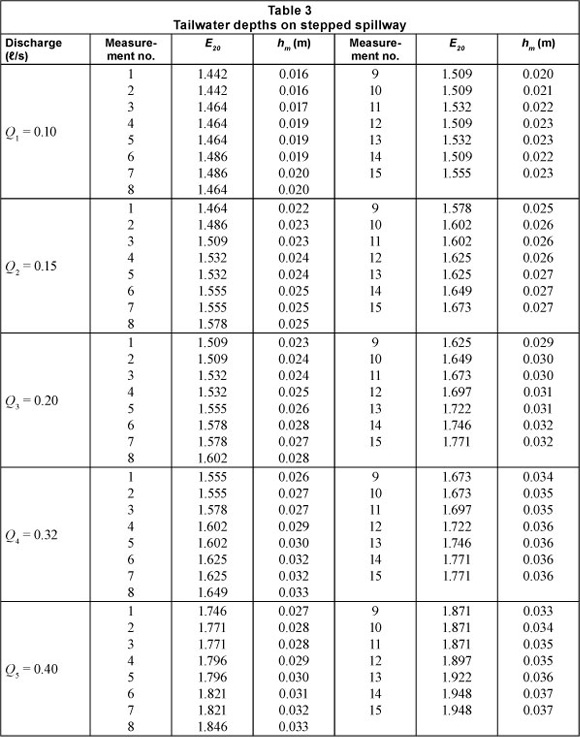


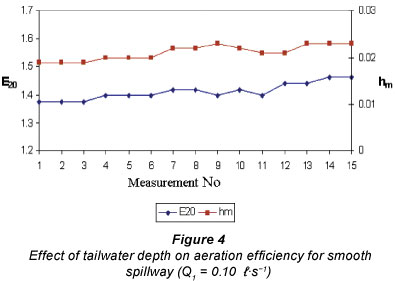
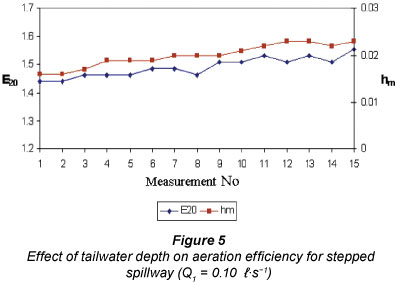
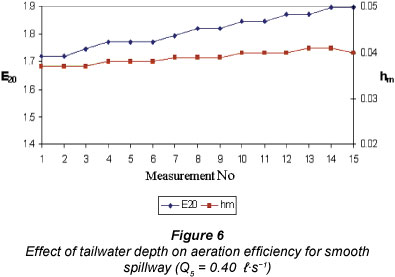
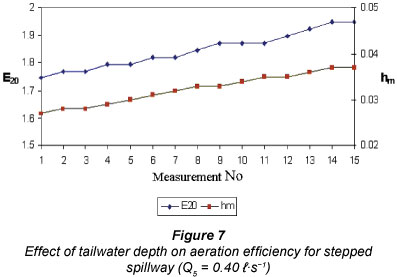
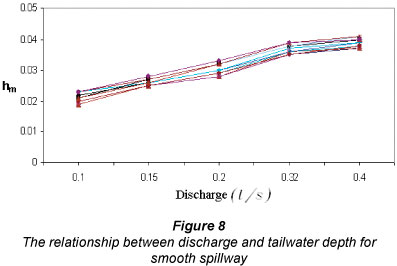
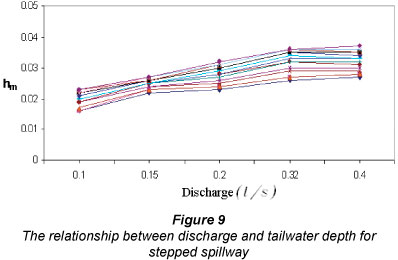
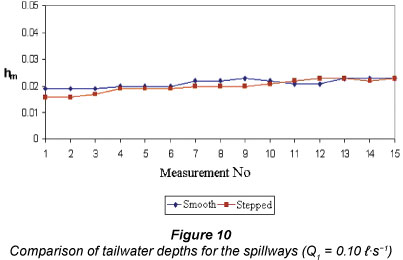
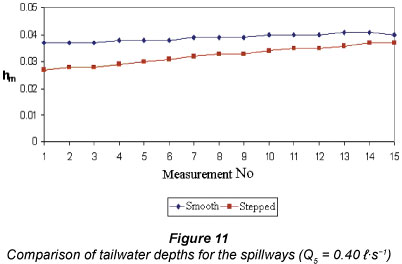
In the model, water jet velocity and penetration depth increased with discharge at the downstream end. At the point of diving, bubbling length increased with the increasing discharge and bubble formation.
For the stepped spillway model, flow regime changes with the discharge values. When the flow passes from the steps (nappe flow), aeration happens with the formation of a water jet and a hydraulic jump. But on the step edges the flow is smooth (skimming flow) for large flow rates (Aras, 2009) (Figs. 2-11).
In the experimental set-up, aeration efficiency is increased by more than 100%, resulting in supersaturated dissolved oxygen concentrations. The average aeration efficiency was between 120% and 130%. This can be seen in Figs. 2 and 3. Figures 4 to 7 shows that aeration efficiency is a direct function of tailwater depth. Aeration efficiency increases with the depth of the tailwater at both low and high flow rates. Also, tailwater depth increases with the discharge (Figs. 8 and 9). Tailwater depth is greater for a smooth spillway than a stepped spillway due to the steps. This can be seen in Figs. 10 and 11.
Conclusions
An exact equation to predict the dissolved oxygen balance of streams has not been developed in previous research, although a wide range of laboratory and field studies have been undertaken and results usually presented in tables or in the form of empirical formulas.
In this study, supersaturated oxygen concentrations indicating higher than 100% aeration efficiencies were found and related graphs and equations have been provided. Duration of air bubbles in the water influenced the oxygen transfer rates downstream of the weir and duration time was dependent on the penetration depth of the air bubbles.
Tailwater depth is an important factor for weir aeration. Aeration efficiency increased with the tailwater depth. E20 values changed in the range of 1.376 to 1.897 for tailwater depth changes in the range of 0.019 m to 0.040 m. In the stepped spillway, aeration efficiency increased with increasing tailwater depth. E20 values changed in the range of 1.442 to 1.948 for tailwater depth changes in the range of 0.016 m to 0.037 m.
This study has shown that dissolved oxygen concentration increased with discharge in both the flat and stepped spillway. The amount of dissolved oxygen showed a gradual increase in value for the first 4 flow rates and a sudden increase was observed at discharges from 0.32 to 0.40 m3.s-1. The reason for this was the change in the flow regime.
The value of the tailwater depth is related to falling height and discharge. Because a fixed height for the model spillways was adopted, tailwater depth is directly dependent on the discharge rate and flow regime. Aeration rate increased with increase in tailwater depth at the toe of the spillway.
In general, tailwater depth in a smooth spillway was greater than tailwater depth in a stepped spillway. This was due to the stepping action of the water flow. While this relationship is more clearly apparent at high flow rates, some exceptional cases occurred at low flow rates. Values were close to each other at low discharge and some values were higher for the stepped spillway in some of the measurements taken at the same flow rate.
Tailwater depths are important to predict oxygen transfer at spillways. Optimum tailwater depth to optimise oxygen transfer may be estimated from former laboratory studies and equations. Too much or too little aeration at the downstream end of spillways can have a negative impact on ecosystems. In addition, accurate estimation of the tailwater depth is one of the major parameters in reducing the cost of the hydraulic structure.
Acknowledgements
Related research was supported by the Research Funds of Karadeniz Technical University - Project No. 2004.112.001.2
References
ARAS E and BERKUN M (2006) Aeration on stepped spillways and its effects on stream reaeration. Seventh International Congress on Advances in Civil Engineering, 11-13 October 2006, Proceedings CD. Yildiz Technical University, Istanbul, Turkey. 1-10. [ Links ]
ARAS E and BERKUN M (2008) Spillway and metal toxicity influenced stream reaeration. J. Environ. Eng. ASCE 134 (9) 809-811. [ Links ]
ARAS E (2009) Effects of Aeration through the Hydraulics Structures on Dissolved Oxygen Balance in Rivers and on the Optimization of Wastewater Treatment System (in Turkish). Ph.D. thesis, Karadeniz Technical University, Department of Civil Engineering, Trabzon, Turkey. [ Links ]
ARAS E and BERKUN M (2010) Comparison of stepped and smooth spillway effects on stream reaeration. Water SA 36 (3) 309-314. [ Links ]
AVERY ST and NOVAK P (1978) Oxygen transfer at hydraulics structures. J. Hydraul. Eng. ASCE 104 (11) 1521-1540. [ Links ]
BALACHANDAR R, KELLS JA and THIESSEN RJ (2000) The effect of tailwater depth on the dynamics of local scour. Can. J. Civ. Eng. 27 (1) 138-150. [ Links ]
BRATTBERG T and CHANSON H (1998) Air entrapment and air bubble dispersion at two dimensional plunging water jet. Chem. Eng. Sci. 53 (24) 4113-4127. [ Links ]
BAYLAR A, EMIROGLU ME and BAGATUR T (2009) Influence of chute slope on oxygen content in stepped waterways. Gazi Univ. J. Sci. 22 (4) 325-332. [ Links ]
BAYLAR A, UNSAL M and OZKAN F (2010) Hydraulic structures in water aeration processes. Water Air Soil Pollut. 210 (1-4) 87-100. [ Links ]
CHANSON H (1994) Hydraulic Design of Stepped Cascade, Channels, Weirs and Spillways. Elsevier Science Ltd., Oxford. [ Links ]
KIM J and WALTERS RW (2001) Oxygen transfer at low drop weirs. J. Environ. Eng. ASCE 127 (7) 604-610. [ Links ]
LING L, CHUNLI Q, QIDONG P, ZHIFENG Y and QIANHONG G (2010) Numerical simulation of dissolved oxygen supersaturation flow over the Three Gorges Dam spillway. Tsinghua Sci. Technol. 15 (5) 574-579. [ Links ]
MOSSA M, PETRILLO A and CHANSON H (2003) Tailwater level effects on flow conditions at an abrupt drop. J. Hydraul. Res. 41(1) 39-51. [ Links ]
NAKASONE H (1987) Study of aeration at weirs and cascades. J. Environ. Eng. ASCE 113 (1) 64-81. [ Links ]
PÓPEL HJ (1974) Aeration and Gas Transfer. Delft University of Technology, Netherlands. 169 pp. [ Links ]
REIN M (1998) Turbulent open channel flows: Drop generation and self aeration. J. Hydraul. Eng. ASCE 124 (1) 98-102. [ Links ]
SANKAR G, BALACHANDAR R and CARRIVEAU R (2008) Tailwater effects on the characteristics of a square jet near a free-surface. J. Hydraul. Res. 46 (4) 504-515. [ Links ]
SUI J, FARUQUE MA and BALACHANDAR R (2008) Influence of channel width and tailwater depth on local scour caused by square jets. J. Hydro-Environ. Res. 2(1) 39-45. [ Links ]
TSAI CW, BEN C and YEN F (2004) Shallow water wave propagation in convectively accelerating open-channel flow induced by the tailwater effect. J. Eng. Mech. ASCE 130(3) 320-336. [ Links ]
WATSON CC, WALTERS RW and HOGAN SA (1998) Aeration performance of low drop weirs. J. Hydraul. Eng. ASCE 124 (1) 65-71. [ Links ]
Received 15 April 2011;
Accepted in revised form 2 April 2012.
* To whom all correspondence should be addressed. +90462 7717250; fax: +90462 7717251; E-mail: egemen@ktu.edu.tr














